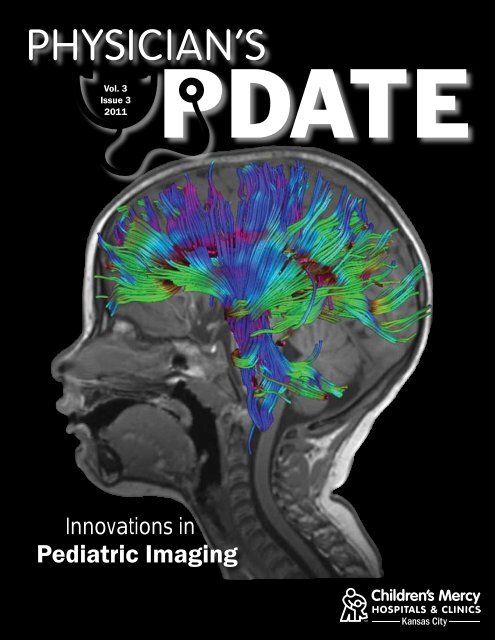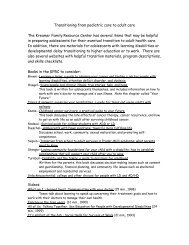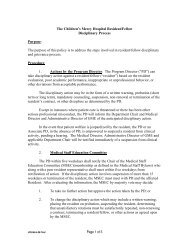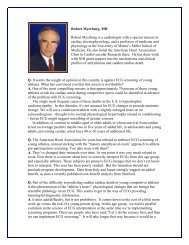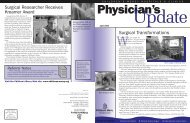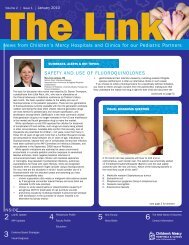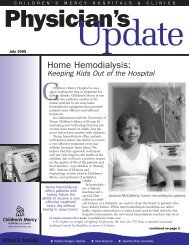Pediatric Imaging - Children's Mercy Hospitals and Clinics
Pediatric Imaging - Children's Mercy Hospitals and Clinics
Pediatric Imaging - Children's Mercy Hospitals and Clinics
You also want an ePaper? Increase the reach of your titles
YUMPU automatically turns print PDFs into web optimized ePapers that Google loves.
Vol. 3Issue 32011Innovations in<strong>Pediatric</strong> <strong>Imaging</strong>
dearCOLLEAGUES,In this issue of Physician’s Update, weare highlighting the Children’s <strong>Mercy</strong>Radiology Department <strong>and</strong> a few of thelatest imaging procedures we are able tooffer you <strong>and</strong> your patients.Radiation exposure is very important to usat Children’s <strong>Mercy</strong> Hospital. In this issue,Dr. Lisa Lowe <strong>and</strong> Dr. Steve Welch discusswhat we are doing to reduce that exposureat Children’s <strong>Mercy</strong>, <strong>and</strong> Nancy Burchell,Radiation Safety Officer, discusses how weare recording all of the radiation exposurea patient obtains at Children’s <strong>Mercy</strong> on aradiation passport that patients take withthem.Also in this issue, Nicki Stang, Child LifeSpecialist, reviews the importance of ourChild Life team <strong>and</strong> our Sedation Teams inreducing the anxiety, length of exam, <strong>and</strong>need for deep sedation; Dr. Fickenscherdiscusses the many benefits of our newpediatric PET/CT scanner; <strong>and</strong> Dr. NeilMardis highlights functional imaging <strong>and</strong>other cutting edge techniques we aredoing with MRI.Finally, I offer a brief introduction to ourphysician portal, which will bring imagesto your computer, laptop or iPhone.We strive to keep the highest level ofimaging services for children <strong>and</strong> theirfamilies. Please let us know what we c<strong>and</strong>o to better serve you <strong>and</strong> your patients.Sincerely,James C. Brown, MDChairmanDepartment of <strong>Pediatric</strong> RadiologyChild Life <strong>and</strong> Sedation TeamDecrease Procedure AnxietyGetting children to hold still longenough for CT scans or MRI’scan be difficult without theuse of sedation, but the combinedefforts of Radiology, Child Life <strong>and</strong> theSedation team at Children’s <strong>Mercy</strong> havedemonstrated success in decreasingthe need for sedation in theseprocedures.Child Life specialists work withthe Sedation Team <strong>and</strong> radiologytechnicians to assess the patient toprovide the best experience possible<strong>and</strong> complete the exam or proceduresuccessfully.“Child Life gets the patient <strong>and</strong> familyfrom the waiting area <strong>and</strong> starts tobuild rapport with them knowingwhether or not a child will be a goodc<strong>and</strong>idate in completing the CT,” saysNicki Stang, Child Life OutpatientSupervisor. “We work with sleepdeprived patients, anesthesia patients,<strong>and</strong> sedation patients all for thecommon goal of trying to complete thisprocedure without the use of sedation.”Child Life <strong>and</strong> the Sedation Teamwork very closely together to makethe experience as comfortable aspossible, employing education, as wellas calming <strong>and</strong> distraction techniquesincluding singing songs, readingstories, <strong>and</strong> using comforting positions.Parents are always allowed to help withthe process.“Our Sedation Team also uses topicalagents for IV starts that helps reducethe child’s experience of pain duringcatheter insertion,” says Stang. “Wehave highly skilled nurses in this areaas well if the child does need to besedated.”Not all children will need sedation.Children’s <strong>Mercy</strong> urges doctors tonot prescribe anything to patients forsedation or self-sedation.“We try to do any scans withoutsedation of the child if possible, so it isimportant that if a patient is referred tous they should not have any sedationorder before arriving to the hospital,”says Kaylene Wiley, RN, Sedation Team.Since 2000, Children’s <strong>Mercy</strong> hasseen a continual drop in the number ofchildren that are sedated. According tostudies done in 2004, there are only5 percent of cases seen in radiologyrequire sedation.
CT/PET Scans: TWO iN ONEAs Children’s <strong>Mercy</strong> <strong>Hospitals</strong><strong>and</strong> <strong>Clinics</strong> continues to grow itspediatric hematology/oncologyprogram, the need to begin performingPET/CT scans on site moved up thepriority list. Thus, as of this past January,the Department of Radiology beg<strong>and</strong>oing the combined scan in house,introducing a more reliable, advancedalternative to the traditional side-by-sidevisual comparison of PET <strong>and</strong> CT scans.While PET (positron emissiontomography) scans show metabolicor chemical activity in a body, CT- computed tomography - imaginghighlights the body’s anatomicalstructures. The fusing of the two imagesis still a fairly new radiological technique,but the method has already emerged ashighly effective in showing detailed viewsof tumors, lymph nodes <strong>and</strong> metastaticlesions.And, when considering cancer patients,it’s the advanced precision of a PET/CTthat has made it the best st<strong>and</strong>ard ofcare.“A PET/CT is an essential diagnostictechnique for cancer patients, helpingto redefine cancer findings, altertreatment plans <strong>and</strong> - sometimes - helppatients avoid unnecessary surgeries,”says Kristin A. Fickenscher, MD,<strong>Pediatric</strong> Radiologist <strong>and</strong>an Assistant Professorof Radiology, UMKCSchool of Medicine.“As the only pediatrichospital in theregion thatis providingthis stateof-the-artprocedure,Children’s<strong>Mercy</strong> isofferinganinvaluableresource forthe treatment of ourpediatric oncologypatients.”Oncology PET <strong>and</strong>PET/CT are used todiagnose, stage <strong>and</strong>restage cancer aswell as to evaluate thepatient’s response totherapy. Specificallyin pediatric oncologypatients, PETparticularly aids in thediagnosis of Hodgkin’sdisease <strong>and</strong> non-Hodgkin’s lymphoma,conditions seen oftenin the Children’s <strong>Mercy</strong>Cancer Center.The new combinedPET/CT scanner housed at Children’s<strong>Mercy</strong> is a 64-slice CT scanner <strong>and</strong> PETscanner in one unit. As one machine, theCT/PET scanner is able to perform allimaging at the same time.“Factoring in our commitment to theImage Gently campaign, we administerchild-size doses with all our PET/CTscans, minimizing exposure even onthe most sophisticated radiologicalprocedures,” adds Dr. Fickenscher.“Our approach allows us to use thecombination of PET/CT to its fullestcapabilities in order to have earlier <strong>and</strong>more accurate detection of diseasesthan either CT or PET alonecan provide.”Dr. Fickenscher <strong>and</strong>her team are doingfour CT/PET scans aweek, but expect thatnumber to increaseas the oncologyprogram at Children’s <strong>Mercy</strong> continuesto exp<strong>and</strong>.In addition, the PET/CT equipmentat Children’s <strong>Mercy</strong> can operate withcombined imaging or individual imaging- solely as a PET or a CT - as the casedictates. Thus, the versatility of thedevice allows other designated “Centersfor Excellence” at Children’s <strong>Mercy</strong> toalso take advantage of the benefits ofthe unit.The Children’s <strong>Mercy</strong> ComprehensiveEpilepsy Center, which received nationalrecognition as a Level IV epilepsy centerin 2010, uses the advancement ofPET to identify seizure focus sites inneurological patients, a critical step indiagnosing <strong>and</strong> treating epilepsy.“Now, our patients - no matter what theirconditions are - have the opportunity tocome to Children’s <strong>Mercy</strong> <strong>and</strong> have alltheir care <strong>and</strong> radiological needs metunder one roof,” adds Dr. Fickenscher.“Having a PET/CT in the Departmentof Radiology allows us to offer a lessdisruptive approach to providing the bestcare for our patients who are in need ofthe most advanced scans in pediatricmedicine.”For more information on PET/CT scansperformed at Children’s <strong>Mercy</strong>, contactthe Department of Radiology at (816)234-3270.
<strong>Imaging</strong> Gently:REDUCiNG RADiAtiON RiSKS FOr CHiLDrENThe risks of exposure to radiation have been known fordecades <strong>and</strong> the risks to children are not debatable.are two to 10 times more sensitive toradiation exposure than adults,” says Lisa Lowe,“ChildrenMD, Children’s <strong>Mercy</strong> <strong>Pediatric</strong> Radiologist <strong>and</strong>Professor of Radiology, University of Missouri-Kansas CitySchool of Medicine. “Children’s tissues are more sensitivebecause they are still developing <strong>and</strong> they have a longerlifetime to manifest exposure, therefore they have more of achance of developing cancer.”Age at time of exposure is the most important risk factor. Fora given dose, it affects a child more than an adult becausethe latency period is much longer. This is a critical factor whendealing with babies or children with illnesses or injuries thatmay require frequent images early in their lives.That is why Children’s <strong>Mercy</strong> has been a strong proponentof the Image Gently guidelines supported by the Society for<strong>Pediatric</strong> Radiology <strong>and</strong> the American Academy of <strong>Pediatric</strong>s.“Children’s <strong>Mercy</strong> has always followed the ALARA guidelines,advocating imaging with radiation at the lowest amountreasonably achievable,” says Dr. Lowe. “The Image Gentlycampaign is the next step. We are doing our part to helpeducate physicians regarding safe imaging.”One study found that less than 20 percent of imagingcenters adjusted doses for children. A review of scans sentto Children’s <strong>Mercy</strong> by outside imaging centers found thatchildren were receiving as much as 50 percent more radiationthan required <strong>and</strong> that the image area was often not optimallytargeted, resulting in exposure to surrounding tissues.Image GentlyPart of the problem has been the difficulty in actuallyquantifying radiation exposure. Trying to st<strong>and</strong>ardize dosesacross various technologies <strong>and</strong> measuring doses absorbedby organs <strong>and</strong> secondary exposure to non-imaged areas isdifficult, according to Steven Welch, MD, Children’s <strong>Mercy</strong><strong>Pediatric</strong> Radiologist <strong>and</strong> Assistant Professor of Radiology,University of Missouri-Kansas City School of Medicine.<strong>Pediatric</strong> radiologists at Children’s <strong>Mercy</strong> recommend followingthe Image Gently guidelines, including:• Reducing or “child-sizing” the amount of radiation utilized• Scanning only when necessary• Scanning only the indicated region• Scanning once; multiphase scanning is usually notnecessary in children“We are always working with physicians to push the dosedownward without compromising quality,” says Dr. Welch.“Often, subspecialists will approach us about how to reduceexposure.”For example, Children’s <strong>Mercy</strong> ENT physicians partneredwith radiologists to reduce the dosage for sinus CT scan, a
commonly prescribed procedure. A screeningexam was implemented using 1/5 the doseof the previous technique, without affectingdiagnostic capabilities.“We start with ‘What do you want to know?’”says Dr. Welch. “You can up the dose <strong>and</strong>get a very pretty image, but it doesn’t addanything to the diagnostic capability.”Children’s <strong>Mercy</strong> radiologists use filteringsoftware, including a program written byNeil Mardis, MD, pediatric radiologist,which can reduce the “noise” in images sothat lower doses of radiation can be usedwhile still maintaining image quality. Thehospital also employs an American Board ofRadiology certified medical physicist who isinstrumental in helping to establish safetylevels.Children’s <strong>Mercy</strong> radiologists have alsodeveloped a series of materials for CommonlyRequested But Frequently Misunderstood<strong>Imaging</strong> Studies, which provide guidelines<strong>and</strong> recommendations for various conditions<strong>and</strong> procedures. The series can be found onthe hospital website at www.childrensmercy.org/radiology.Safe Alternatives“The addition of a single CT in an infantincreases risks of developing cancer from 25percent to 25.01 percent,” says. Dr. Lowe.“That is a very small number. But the personwho does develop a malignancy is 100percent affected.”Children’s <strong>Mercy</strong> offers a full range of imagingtechniques including no radiation alternativessuch as ultrasound, MRI <strong>and</strong> PET.“We start by looking at what is the right testfor the child <strong>and</strong> then child size the dosing tomake it appropriate,” says Dr. Welch. “We’retrying to change pediatric radiology, one childat a time, because every child matters.”DON’t FOrGEt YOUrDOSE PASSpOrtDoes your patient need an X-ray?Don’t forget to ask for his or herDose Passport first.Children’s <strong>Mercy</strong> is the first pediatrichospital in the region to use aDose Passport to record a patient’sradiation exposure.“We recognize that we need to limit radiation exposure,especially in children because they are the most vulnerable toits long-term effects,” says Nanci Burchell, Radiation Safety Officerat Children’s <strong>Mercy</strong>. “This is an efficient way to monitor thosedoses.”Currently in phase one ofimplementation, the DosePassport is distributedto parents as a 3.5x4.5card similar to a patient’svaccination record. Theparents are instructedto carry the card forsubsequent visits tothe hospital or to theirchildren’s doctoror dentist visits,recording every x-rayexam.Soon, the DosePassport willconvert into anelectronic format <strong>and</strong> willinclude dose amounts. At this time, thereare no government requirements for tracking radiationdosage, but Burchell believes this will change soon.“In many cases, the Dose Passport helps physicians <strong>and</strong>radiologists determine the best test for the clinical question beingasked,” adds Burchell. “Plus, this should help everyone avoidordering duplicate exams.”To learn more about the Dose Passports used at Children’s <strong>Mercy</strong>,call (816) 234-3270.
ADVaNCING THEDIaGNOSTICPOWERS OF MRIWith a 3 Tesla MRI unit, plus two 1.5 Tesla units, Children’s<strong>Mercy</strong> is the only pediatric provider in the region capableof providing advanced pediatric neurological, orthopaedic,<strong>and</strong> cardiac imaging procedures.Beyond the powerful MRI unitsthemselves, Children’s <strong>Mercy</strong> isleading the way into advancedimaging using the current technologyin new ways to provide more detailedinformation to help physicians, surgeons<strong>and</strong> parents make more informeddecisions.Functional <strong>Imaging</strong>Functional imaging looks at functionsof different parts of the brain <strong>and</strong> usesunique paradigms to test differentfeatures, for example, what parts of thebrain are involved in motor activity orspeech.“The idea behind functional imaging isthat you can match areas of function tothe anatomic images we are acquiring<strong>and</strong> give neurologists a better idea ofwhat is going on in certain portionsof the brain,” says Neil Mardis, DO,pediatric radiologist. “So if you weregoing to plan for surgery, you couldmap the parts of the brain which areresponsible for specific activities orabilities <strong>and</strong> the locations of these areaswith respect to areas of pathology.”That information could then be usedto preserve more eloquent areas <strong>and</strong>preserve function, or provide a betteridea of what sort of morbidity would beinvolved with surgery.Functional MRI may be useful in betterunderst<strong>and</strong>ing differences in how thebrain works in autistic children, theeffect of resecting the seizure focusin the brain of a child with epilepticseizures, or determining thebest pathway to resect a tumor.Functional imaging is not inwidespread clinical use yet.Children’s <strong>Mercy</strong> has acquiredthe additional software to dofunctional imaging <strong>and</strong> Dr.Mardis hopes to start offeringfunctional MRI by fall 2011.“This is an advanced diagnosticprocedure. It is morecommonly used in patients witha known pathology or disorder,”he says. “If it is something youare considering, you shouldprobably discuss it with thespecialist or radiologist todetermine if it is going to yieldinformation that is clinicallyuseful.”Cartilage MappingCartilage mapping is a newtechnique which provides amore detailed look at cartilageto diagnose injuries at a muchearlier stage.“With cartilage disease, we were lookingat whether the cartilage is frayed,disfigured, or if there are cartilagedefects. The cartilage is alreadydamaged at this point,” says Dr. Mardis.“Using this new technique, we canlook at the microstructural makeup ofthe cartilage, <strong>and</strong> can see changes incartilage that happen before there ismacroscopic damage.”This could be important to injuryprevention as once cartilage is lost,growing it back is difficult <strong>and</strong> thecartilage that does grow back is not thesame.Children’s <strong>Mercy</strong> is also doing researchwith this technique to better underst<strong>and</strong>the makeup of healthy cartilage inchildren versus adults.For more information on MRI procedures<strong>and</strong> these techniques, contactRadiology at (816) 234-3270.
Viewing X-Rays WitH tHE CLiCK OF A MOUSENo more relying only ondescriptions over the phone.No more being at themercy of the patient returning adisk of images. Soon, communityphysicians will have a better, fasteroption for viewing patients’ x-raysfrom the Department of Radiologyat Children’s <strong>Mercy</strong> <strong>Hospitals</strong> <strong>and</strong><strong>Clinics</strong>.Currently, doctors who refer patientsfor x-rays at Children’s <strong>Mercy</strong> donot have easy access for viewingimages. But, that’s set to changeas the Department of Radiologyintroduces a radiology physicianportal that will allow physicians toaccess patient images - includingCTs, nuclear medicine, MRIs <strong>and</strong>more - with the click of a mouse.“All of our referring physicians willbe able to log in, view <strong>and</strong> haveaccess to their patients’ images assoon as they are made availableby our pediatric radiologists,” saysJames C. Brown, MD, DepartmentChair, <strong>Pediatric</strong> Radiologist <strong>and</strong>Associate Professor of Radiologyat the UMKC School of Medicine.“We’ll be able to communicate moreeffectively with both parties beingable to review the images at thesame time.”Set to be an option on the hospital’sPhysician Portal website - www.childrensmercy.org/physicians -later this year, the radiology portalwill be password restricted forreferring physicians.To inquire more about the RadiologyPhysician Portal at Children’s<strong>Mercy</strong>, call (816) 234-3272 or emailDr. James Brown atjcbrown@cmh.edu.<strong>Pediatric</strong> Radiology FacultyJames C. Brown, MDChairman, Department of<strong>Pediatric</strong> RadiologyAssociate Professor ofRadiologyBrent E. Cully, MD<strong>Pediatric</strong> RadiologistSection Chief, Nuclear MedicineAssistant Professor of Radiology<strong>Pediatric</strong> InterventionalRadiology <strong>and</strong> <strong>Pediatric</strong> NuclearMedicineKristin A. Fickenscher, MD<strong>Pediatric</strong> RadiologistProgram Director, <strong>Pediatric</strong>Radiology FellowshipSection Chief, Fetal MRIAssistant Professor of RadiologyFetal MRI, <strong>Pediatric</strong> CardiacMRI, <strong>Pediatric</strong> PET/CTJoshua Knowlton, MD<strong>Pediatric</strong> RadiologistDirector, Radiology MedicalStudent EducationAssistant Professor of Radiology<strong>Pediatric</strong> Cardiac MRI, <strong>Pediatric</strong>MusculoskeletalEmily D. Kucera, MD<strong>Pediatric</strong> RadiologistSection Chief, UltrasoundDirector, Radiology Services,Children’s <strong>Mercy</strong> SouthAssistant Professor of Radiology<strong>Pediatric</strong> Body <strong>Imaging</strong>C. Anthony Lawrence Jr., MD<strong>Pediatric</strong> RadiologistDirector, Radiology Services,Children’s <strong>Mercy</strong> <strong>Clinics</strong> onBroadwayAssistant Professor of Radiology<strong>Pediatric</strong> Body <strong>Imaging</strong>Lisa Lowe, MD<strong>Pediatric</strong> RadiologistRadiology Program DirectorAcademic Chairman <strong>and</strong>Professor of Radiology<strong>Pediatric</strong> NeuroradiologyNeil J. Mardis, DO<strong>Pediatric</strong> RadiologistSection Chief, MRISection Chief, Cardiac <strong>Imaging</strong>Assistant Professor of Radiology<strong>Pediatric</strong> MRI, <strong>Pediatric</strong>Musculoskeletal, Cardiac MRI<strong>and</strong> PET/CTMegan McDonald, DO<strong>Pediatric</strong> RadiologistSection Chief, MusculoskeletalAssistant Professor of Radiology<strong>Pediatric</strong> MusculoskeletalDavid B. Nielsen, MD<strong>Pediatric</strong> RadiologistDirector, Radiology Medical ITAssistant Professor of Radiology<strong>Pediatric</strong> NeuroradiologyKay Lynn North, DO<strong>Pediatric</strong> RadiologistAssistant Professor of Radiology<strong>Pediatric</strong> Body <strong>Imaging</strong>Brenton D. Reading, MD<strong>Pediatric</strong> RadiologistSection Chief, FluoroscopyAssistant Professor of Radiology<strong>Pediatric</strong> InterventionalRadiologyDouglas C. Rivard, DO<strong>Pediatric</strong> RadiologistVice ChairmanSection Chief, InterventionalAssistant Professor of Radiology<strong>Pediatric</strong> InterventionalRadiology, <strong>Pediatric</strong> PET/CTCynthia Taylor, MD<strong>Pediatric</strong> RadiologistDirector, Radiology Services,Children’s <strong>Mercy</strong> Northl<strong>and</strong>Assistant Professor of Radiology<strong>Pediatric</strong> Body <strong>Imaging</strong>,<strong>Pediatric</strong> PET/CTCharlotte Waugh Moore, MD<strong>Pediatric</strong> RadiologistAssistant Professor of Radiology<strong>Pediatric</strong> Body <strong>Imaging</strong>In academic affiliation with theUniversity of Missouri-Kansas City.Steven Welch, MD<strong>Pediatric</strong> RadiologistSection Chief, CTAssistant Professor of Radiology<strong>Pediatric</strong> Neuroradiology,<strong>Pediatric</strong> Musculoskeletal,<strong>Pediatric</strong> Body <strong>Imaging</strong> <strong>and</strong>Timothy Zinkus, MD<strong>Pediatric</strong> RadiologistSection Chief, NeuroradiologyAssistant Professor of Radiology<strong>Pediatric</strong> Neuroradiology
Physician Services2401 Gillham RoadKansas City, MO 64108-4698Non-Profit Org.U.S. PostagePAIDKansas City, MOPermit #4301Return Service RequestedChildren’s <strong>Mercy</strong> is an equal opportunity/affirmative action employer <strong>and</strong> a UnitedWay Agency.Taylor14 years oldKelli <strong>and</strong> Tom Gabel don’t mind making the 70-miledrive from Topeka, Kan., to bring their daughterTaylor to Children’s <strong>Mercy</strong> for a radiologyappointment. Diagnosed in May 2009with stage 4 Hodgkin’s lymphoma, Taylorreceives a PET scan <strong>and</strong> other imagingprocedures about every month.Previously, they had to have proceduresdone in two different places, but thatroutine changed in January whenChildren’s <strong>Mercy</strong> installed its own PET/CT.“We were getting our scans at a place thatgenerally deals with adults <strong>and</strong> are not setup to h<strong>and</strong>le kids like Children’s <strong>Mercy</strong> is,”says Kelli.The caring, child-centered approach of Children’s<strong>Mercy</strong> isn’t lost on the Gabels.“With the support <strong>and</strong> care thatthe entire Radiology staffprovides, Taylor has reallycalmed down <strong>and</strong> hasvery little anxiety whenit comes to the scan,”adds Kelli. “I have toldmany that I wouldnever second guessour decision tohave her treated atChildren’s <strong>Mercy</strong>,where everythingis centered aroundthe kids!”How ToReferFor Transport,InpatientAdmission or forConsult1-800 GO MERCY(1-800-466-3729)Call this number 24 hours a day tomobilize the in-house neonatal orpediatric transport teams, consultwith a specialist, or admit a patientdirectly to Children’s <strong>Mercy</strong> Hospital orChildren’s <strong>Mercy</strong> South.For Specialty Clinic Appointments(816) 234-3700 ortoll free 1 (800) 800-7300Nurses with our Physician Appointmentline can assist you with schedulingclinic appointments for Children’s<strong>Mercy</strong> Hospital, Children’s <strong>Mercy</strong> South<strong>and</strong> Children’s <strong>Mercy</strong> Northl<strong>and</strong>.Physician’s Update is produced byCommunity Relations.Shawn ArniEditorMegan StockAssistant EditorFor more information, callCommunity Relations at 816-346-1370.For more physician news <strong>and</strong>information, visit ourPhysician News portal atwww.childrensmercy.org/physicians.


